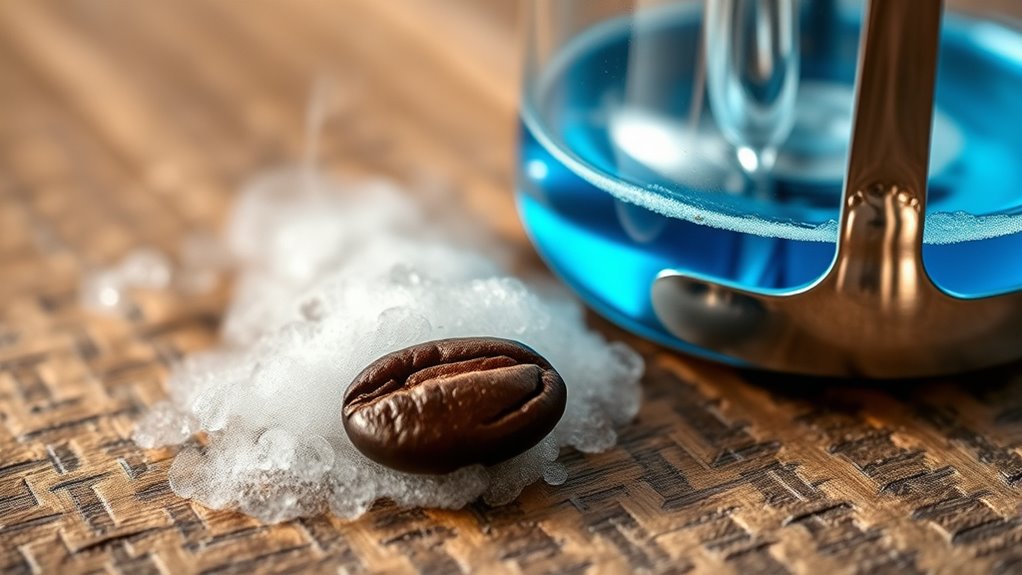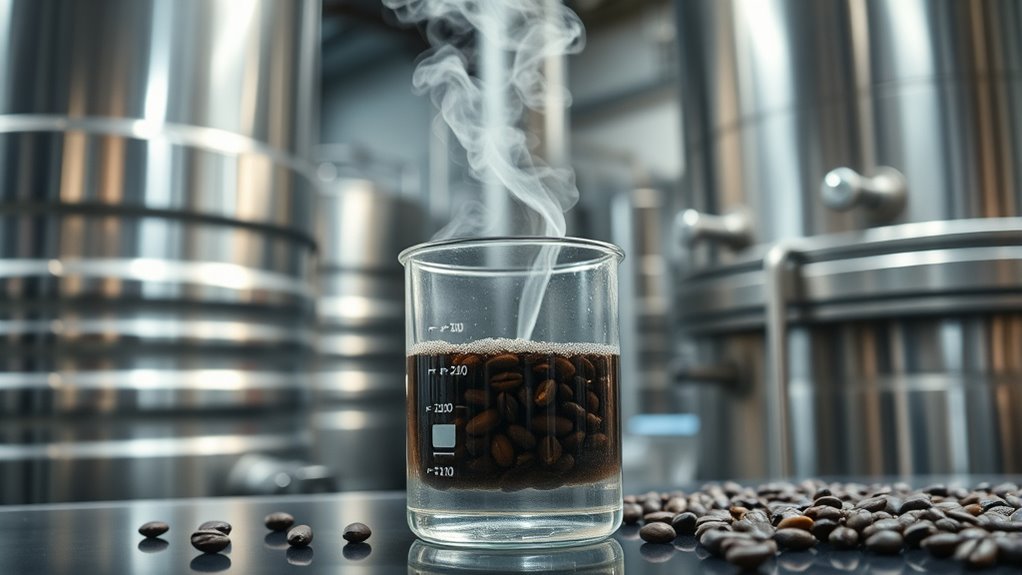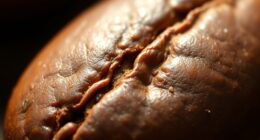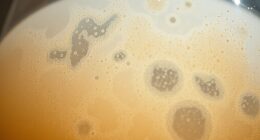Decaffeination methods remove caffeine from coffee beans using different techniques. Some use chemical solvents like methylene chloride or ethyl acetate, while others rely on water and natural processes. The Swiss Water process uses osmosis without chemicals, and the CO₂ method employs supercritical carbon dioxide to target caffeine specifically. Each approach aims to keep the flavor intact, but they differ in cost and chemical use. If you want to learn precisely how each method works, more details await you.
Key Takeaways
- Coffee beans are treated with steaming or soaking to open pores before caffeine removal.
- Solvent-based methods use chemicals like methylene chloride or ethyl acetate to extract caffeine.
- Water-based processes, such as the Swiss Water Method, use osmosis and caffeine-binding extracts without chemicals.
- Supercritical CO₂ selectively bonds with caffeine, enabling targeted extraction while preserving flavor.
- Final steps often involve removing residual chemicals or solvents to ensure safe, decaffeinated coffee.

Decaffeination methods encompass several techniques designed to remove caffeine from coffee beans while preserving flavor. When you choose decaf, you’re opting for a process that starts with treating green beans to open their pores, often by steaming or soaking. From there, the methods diverge into four main categories: direct-solvent, indirect-solvent, Swiss Water, and CO₂ processes. Each employs different mechanisms and equipment, and some use chemicals, while others rely on water or supercritical CO₂.
Decaffeination techniques vary, using chemicals, water, or CO₂ to preserve flavor while removing caffeine.
The production of decaf coffee is more complex and costly than regular coffee because of these specialized steps and machinery involved.
In the direct-solvent process, the beans are steamed for about 30 minutes to loosen their structure. They then get rinsed with chemical solvents like methylene chloride or ethyl acetate for roughly 10 hours. Ethyl acetate is sometimes called “natural decaf” because it occurs naturally in fruits. After rinsing, the beans undergo a final steaming to remove any residual chemicals, and the roasting or brewing process heats away any remaining traces.
This method is quite common and is considered safe, with regulatory agencies like the FDA approving methylene chloride at very low levels—less than 10 parts per million.
The indirect-solvent method involves soaking the beans in hot water first, which leaches out caffeine along with oils and flavors. The resulting caffeine-rich water is then treated with solvents outside the beans, skimming off the caffeine while keeping flavor compounds intact. Water-based extraction is a key component of this process, emphasizing its natural approach.
This caffeine-free water, now flavor-rich, is returned to the beans to reabsorb the oils and flavors. Sometimes, this method is branded as “water-processed” decaf. It’s designed to preserve as much of the original flavor as possible, making it popular among those seeking a more natural approach.
The Swiss Water process takes a different route by eliminating chemicals altogether. It uses osmosis, where caffeine-laden water extracts caffeine from the beans without any solvents. A proprietary green coffee extract binds to caffeine, pulling it out without stripping away much of the flavor.
This process is certified organic and kosher because it’s chemical-free, but it takes longer and costs more due to the intricate steps involved. The longer processing time adds to the overall expense but appeals to consumers prioritizing natural methods.
Lastly, the CO₂ method employs supercritical carbon dioxide, which acts like both a liquid and gas under high pressure. The CO₂ selectively bonds with caffeine molecules, which are then filtered out through activated charcoal.
This method is highly effective at preserving flavor because it targets caffeine specifically, but it’s also the most expensive due to the need for specialized equipment. Overall, each method aims to balance caffeine removal efficiency with flavor preservation, but none can eliminate caffeine entirely—most decaf retains about 3% of the original caffeine content.
Frequently Asked Questions
Are Decaffeination Methods Safe for All Health Conditions?
You wonder if decaffeination methods are safe for all health conditions. While most processes are considered safe and regulated, some chemicals like methylene chloride may raise concerns for sensitive individuals.
Decaf coffee generally benefits health, but if you have allergies or sensitivities to certain chemicals, choose chemical-free options like the Swiss Water Process.
Always check labels and consult your healthcare provider if you’re unsure about how decaf coffee affects your specific health needs.
How Do Different Decaffeination Processes Affect Coffee Flavor?
You might notice that different decaffeination processes impact coffee flavor differently. Solvent-based methods can slightly alter taste, while Swiss Water and CO2 extraction preserve more of the original flavor.
Mountain Water is gentle and maintains aroma and complexity.
Your preferred method depends on whether you prioritize flavor preservation, environmental concerns, or chemical-free options.
Keep in mind, the process used will influence the coffee’s richness, aroma, and overall taste experience.
Is Decaffeinated Coffee More Expensive Than Regular Coffee?
Think of decaf as a luxury car, priced higher due to extra features. Yes, decaffeinated coffee is more expensive than regular coffee.
You pay for the labor-intensive process, specialized equipment, and lower production volumes, all adding to the cost.
Plus, the demand remains steady among coffee lovers who prefer decaf, keeping prices elevated.
Can Decaffeination Remove All Caffeine From Coffee Beans?
You wonder if decaffeination can remove all caffeine from coffee beans. Generally, it can’t, because regulations require at least 97% to 99% of caffeine to be removed, depending on the standard. So, some caffeine always remains in decaffeinated coffee.
You might notice a small amount of caffeine, but it’s usually minimal, making it safe for most people seeking reduced caffeine intake.
Do Decaffeination Methods Vary by Coffee Bean Origin?
Ever wonder if the origin of your coffee bean affects how it’s decaffeinated? While bean characteristics influence flavor, the decaffeination methods you encounter—like Swiss Water or solvent-based processes—are generally consistent across origins.
You’ll find that regional preferences shape the process choices, not the beans’ origin. So, your decaf coffee’s process is more about regional standards and consumer demand than where the beans come from.
Conclusion
Now that you know how coffee loses its caffeine, you’ll appreciate the process even more. Did you know that about 98% of caffeine can be removed using decaffeination methods? Whether you prefer the Swiss Water or CO2 process, understanding these techniques helps you choose your perfect cup. Next time you sip your decaf, remember the fascinating science behind it—it’s a clever blend of chemistry and craftsmanship working to deliver your favorite flavor without the jolt.









